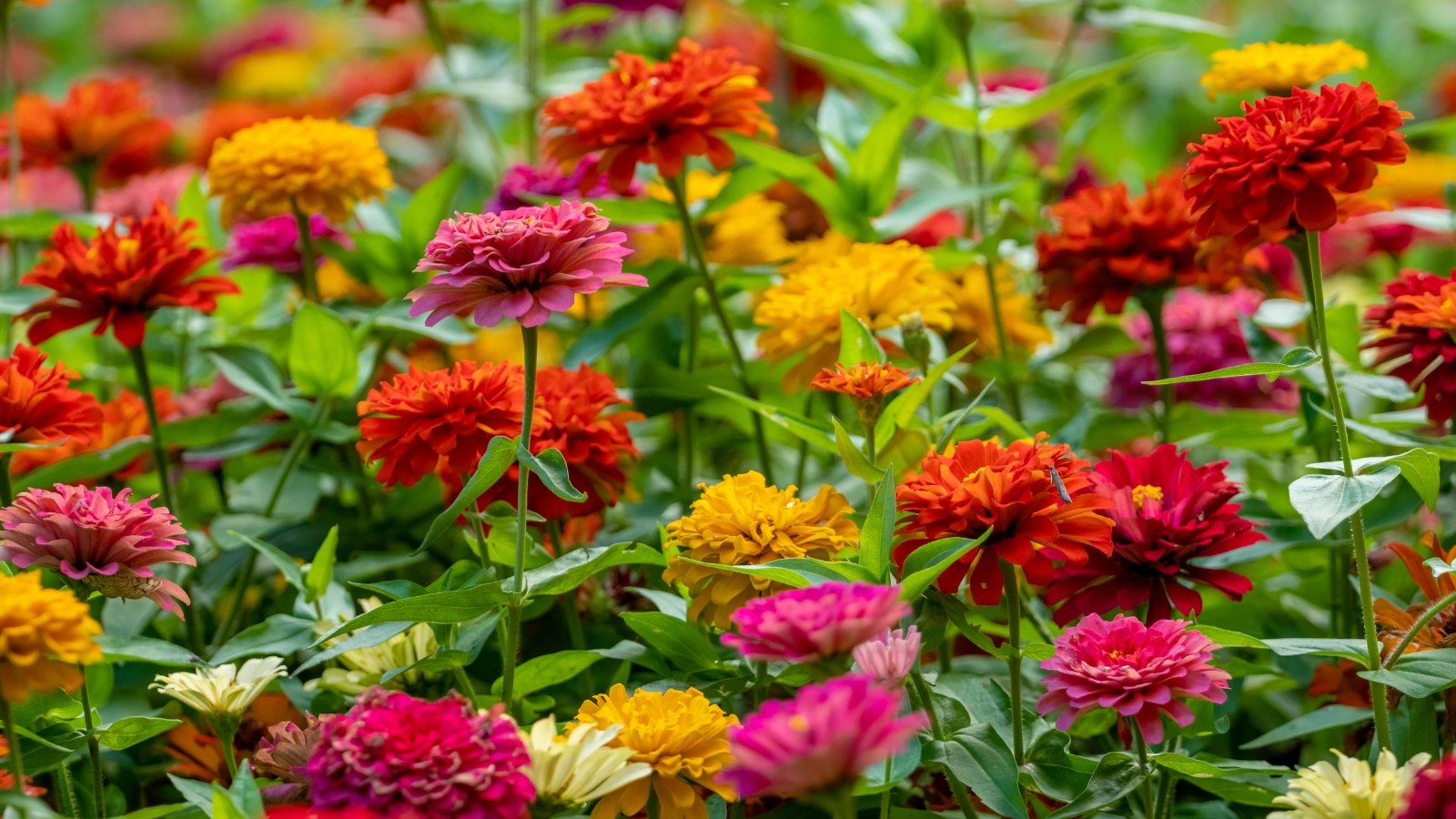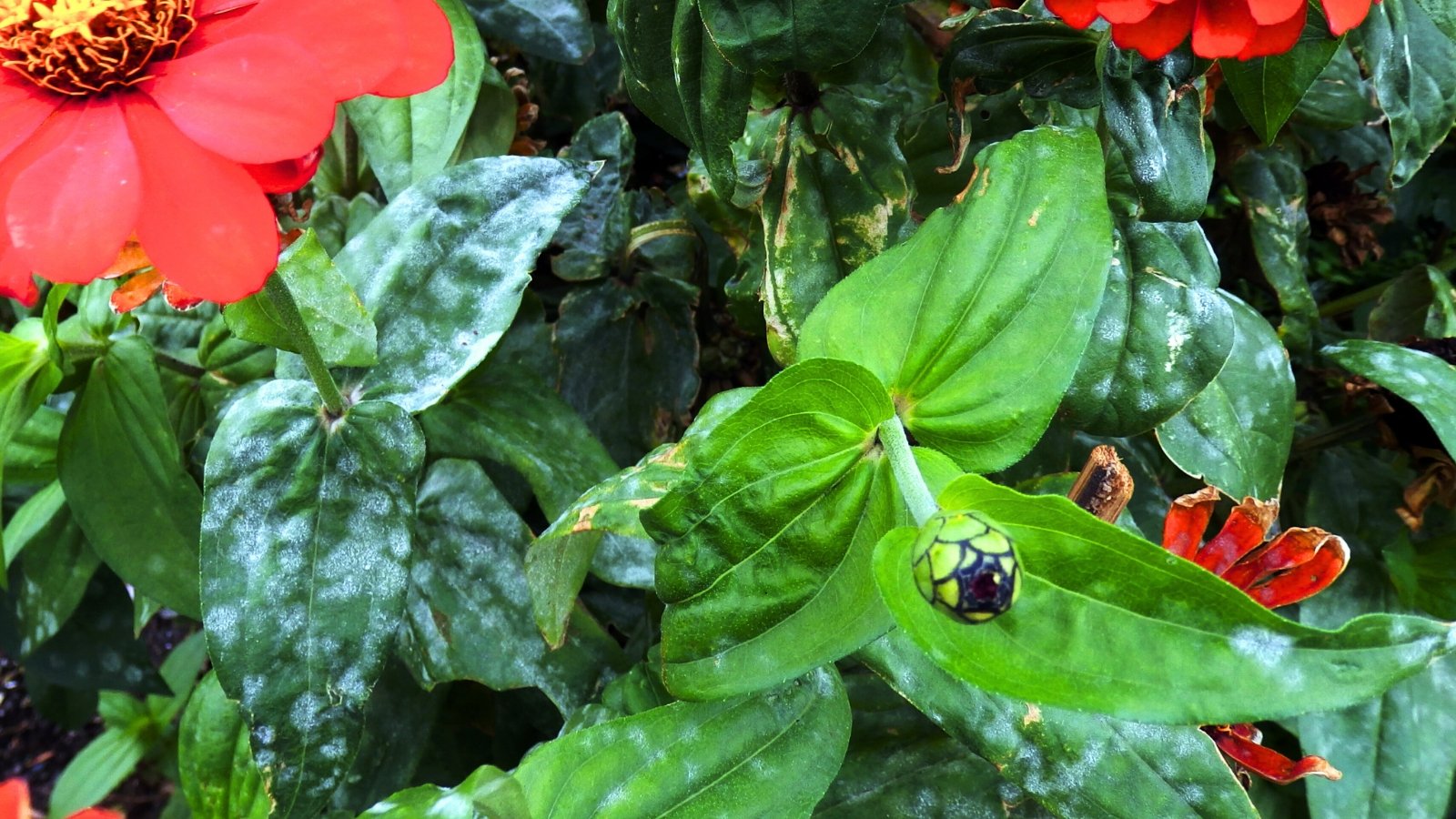PROTECT YOUR DNA WITH QUANTUM TECHNOLOGY
Orgo-Life the new way to the future Advertising by AdpathwayZinnias are vibrant, low-maintenance flowers that we love for their bold, long-lasting flowers and easy-going nature. These members of the daisy family love warm, summer weather. A wide range of forms and colors makes them perfect for any sunny space in the garden.
From small single cultivars to double-petaled ‘California Giants’ zinnias, these cheerful flowers are always charming. Their long, continuous blooming season lasts from early summer until frost. Their high impact in the garden, paired with their strong appeal to pollinators, makes these zinnias a win in my book!
California Giants Blend Zinnia Seeds

- Continuous Flowering – The More You Cut, the More They Bloom
- Edible Petals Add Color to Salads and Drinks
- Attracts Pollinators and Resists Deer
- Tall, Heat-Loving Plants Perfect for Borders and Bouquets
‘California Giants’ Zinnia Overview

|
Plant Type Annual Family Asteraceae Genus Zinnia Species Elegans |
Native Area Central America, Mexico Exposure Full sun Height 2’-4’ Watering Requirements Low to Moderate |
Pests & Diseases Aphids, spider mites, whiteflies, armyworms, leafhoppers, Japanese beetles, root rot, and powdery mildew Maintenance Low Soil Type Loamy, fertile, well-drained Hardiness Zone 2-11 |
What Is It?
 Tall and vibrant, they bring height and drama fast.
Tall and vibrant, they bring height and drama fast. ‘California Giants’ zinnias are an impressive heirloom known for their large, dahlia-form blooms in vibrant colors. They make an excellent addition to the cutting garden, with long-lasting flowers on tall, strong stems. Their beauty, coupled with their ease of care, makes these a fantastic addition to cutting gardens, containers, and flowerbeds.
Characteristics
 Their five-inch flowers turn heads and attract fluttering butterflies.
Their five-inch flowers turn heads and attract fluttering butterflies.‘California Giants’ is a large, flowering variety of zinnia characterized by its bold, vibrant flowers. They often reach five inches in diameter, making them one of the largest cultivars. The substantial blooms are usually semi-double to fully double, with a dahlia-like form.
The blooms in shades of red, orange, pink, white, purple, and yellow are attractive to pollinators. Butterflies, in particular, love to drink nectar from zinnias. Their wide, often open flowers are easily accessible to pollinators.
The plants are upright and branching, and they branch more when you cut and deadhead the flowers. They’re great for cutting gardens and the back of borders.
These begin blooming in late spring to early summer, depending on your climate. With proper care, they will continue to produce flowers right up until your first frost.

Native Area
 They grow strong where the sun shines longest and brightest.
They grow strong where the sun shines longest and brightest.Zinnia elegans is native to Mexico and parts of Central and North America. They typically grow wild in warm, arid, and semi-arid regions. ‘California Giants’ zinnia is a cultivated strain that is well-suited to a wide range of climates.
Planting
The best time to plant your ‘California Giants’ zinnias is in the spring, as soon as the weather is warm enough. While you can start them indoors early, they are easiest to sow directly in the garden.
These are a large type of zinnia, and they need some space to spread out. Keep this in mind when deciding on a location. Ideally, your plants will grow large and shrubby, producing an abundance of flowers.
Transplanting
 Skip transplanting and sow straight in warm garden beds.
Skip transplanting and sow straight in warm garden beds.If you live in a warm climate, you’ll likely start your seeds directly in the garden, eliminating the need for transplanting. You may want to purchase and plant nursery starts, however, and these you’ll need to transplant. In cooler climates, you may decide to start your seeds indoors earlier in the season.
It’s a good idea to work some fertilizer into the soil at planting time. Loosen the soil in the area where you want to plant your zinnias. Dig holes that are as deep and twice as wide as the root balls. Space your seedlings or start about 18″-24″ apart and backfill around them. Tamp the soil down lightly, and water thoroughly.
Growing From Seed
 Two seeds per hole helps hedge those germination bets.
Two seeds per hole helps hedge those germination bets.The easiest way to propagate zinnias is from seeds. I have found that sowing your seeds directly in the garden is the most convenient and effective method. In mild to warm climate areas, simply wait for the soil to reach about 65°F (18°C). Once it’s warm enough, sow your seeds directly in your garden beds.
‘California Giants’ zinnias are flexible but partial to rich, loamy soil. If you are starting with poor soil, consider amending it with compost ahead of planting time. Sow your seeds at intervals of 18″-24″, and about 1/4″ deep. I prefer to drop two seeds into each hole, I thin them to one per hole if more than one sprouts.
While you’re waiting for your seeds to germinate, keep the soil moist. Soggy soil can rot your seeds and seedlings. If the soil is warm enough, zinnia seeds can germinate in as few as four days, but can take up to two weeks. After your seeds sprout, thin out the weaker ones, leaving the stronger seedlings about 18″ apart.
Keep the soil moist while your plants are growing, but be careful not to overwater them. If you have heavy soil, such as soil with a high clay content, it’s essential to monitor moisture levels.
There is nothing wrong with starting your seeds indoors, especially if you live in a cooler climate. It’s not difficult, but it takes more consideration than direct sowing. A grow light or space with bright, indirect light is necessary, and a heating mat can be helpful.
Use a well-draining seed-starting mix in your seed-starting cells. It’s important to maintain light moisture in the potting mix, but avoid allowing it to remain wet or soggy. If your seedlings stay wet, they are at risk of damping off. Once the outdoor soil reaches a temperature of 65°F (18°C), it’s safe to transplant your seedlings.
How to Grow
‘California Giants’ zinnias are easy to grow and care for. They mature quickly and bloom in as little as 60 days. They are a great addition to the pollinator and cutting gardens.
Light
 A sunny spot keeps them upright and blooming strong.
A sunny spot keeps them upright and blooming strong.If you want to make the most of your ‘California Giants’ zinnias, they need six to eight hours of sunlight daily. If they don’t get enough sun, you may end up with leggy, weak plants that don’t flower well.
Sunlight is essential for taller varieties as it promotes strong, sturdy stems. Sunlight also helps combat fungal issues by evaporating moisture from the leaves more quickly.
Water
 Skip the sprinkle—give them a deep drink instead.
Skip the sprinkle—give them a deep drink instead.Once they’re established, zinnias are fairly drought-tolerant. However, their preferred state is moderate moisture. If you want to maximize your blooming power, water is a necessity.
The best time to water is early morning, when the air is cool, allowing the water to evaporate more slowly. Overhead watering leaves foliage wet, which can lead to the development of fungal diseases. Watering at the soil level is important for your ‘California Giants’ zinnias.
If you live in a region that receives rain regularly, you may not need to water your established zinnias. During times of drought, water two to three times per week, allowing the water to run deep. Soak the soil, then let the surface dry before watering again.
Soil
 Soil that holds moisture but drains well is perfect here.
Soil that holds moisture but drains well is perfect here.Loose, light, and loamy is the ideal type of soil for your ‘California Giants’ zinnias. It needs good drainage, but should also be moderately fertile and hold moisture. Sandy loam is the ideal soil composition.
If you have heavy soil, such as soil with a high clay content, you’ll likely need to amend it with sand or perlite to improve drainage. Moderately fertile soil is ideal, but excessive nitrogen can lead to excessive green growth and fewer flowers. They grow best in slightly acidic pH conditions.

Temperature and Humidity
 Give them breathing room in humid spots to avoid mildew.
Give them breathing room in humid spots to avoid mildew.‘California Giants’ zinnias are happiest in warm, dry climates. They are heat-tolerant, and once established, they are relatively drought-tolerant. However, a lack of moisture will inhibit flowering.
When it comes to cold weather, zinnias are not frost-tolerant at all. The ideal temperatures for growth and flowering are between 70 and 90°F (21-32°C) during the day and about 10°F lower at night. Be sure to wait until all chance of frost has passed before you put these outside.
Low to moderate humidity is preferable. High humidity increases the risk of fungal diseases, especially powdery mildew. In humid climates, give your plants a little extra space for adequate ventilation.
Fertilizing
 Balanced fertilizer at planting sets the stage just right.
Balanced fertilizer at planting sets the stage just right.Mix some organic fertilizer or compost into your soil at planting time to give your ‘California Giants’ zinnias a strong start. This is the only instance where a balanced formula is suitable. Too much nitrogen will actually inhibit flowering.
About four weeks after planting, apply a formula with higher potassium and phosphorus. This will help with bud development and produce stronger blooms overall. Repeat every four to six weeks throughout the blooming season.
Maintenance
 Snip spent blooms just above a fresh, growing branch.
Snip spent blooms just above a fresh, growing branch.Because they are annuals, there is minimal maintenance required at the end of the season. The most important aspect of maintenance for your ‘California Giants’ is deadheading. If you’re growing zinnias in the cutting garden, be sure to cut them regularly.
Make your cuts directly above a node with a new branch growing alongside the stem you’re snipping. If you’re growing them as ornamentals in your beds and borders, make sure you deadhead the spent blooms. You should also cut the stem all the way down to a branching node in this event. This keeps your plants sturdy and bushy.
Propagation
 Let seed heads dry out before collecting for next season.
Let seed heads dry out before collecting for next season.You can propagate zinnias by cuttings, but the method is not entirely reliable. Since they are annuals and it’s easy to propagate them with seeds, that’s usually the method of choice. Allow your seed heads to ripen at the end of the season and harvest seeds for the next season if you want more ‘California Giants!’
Common Problems
Under ideal circumstances, zinnias are sturdy plants that have few issues with pests or diseases. If you’re growing them in a humid climate, be aware. There is a good chance you’ll run into a problem or two along the way.
Pests
 Catching bugs by hand often saves plants from bigger problems.
Catching bugs by hand often saves plants from bigger problems.Aphids are a common garden pest, but are relatively easy to deal with. Simply spray your zinnias with a strong stream of water from a hose to knock them off the plant. This prevents further feeding.
In my garden, armyworms are the most detrimental zinnia pests. These tiny caterpillars defoliate plants in no time at all. They can also be difficult to deal with. While you can try to deal with them using neem oil, I find it’s more effective to just pull the plant.
Whiteflies also like zinnias, but they are easier to control. Neem oil is effective against them. You can also hang yellow sticky traps. They are attracted to the traps, and this will significantly decrease their populations. This attracts other insects that are drawn to yellow, though.
If you live in a warm, dry climate, the pests most common to bother your ‘California Giants’ zinnias are spider mites. Misting your plants with water can be beneficial, as they tend to dislike high humidity and moisture. Neem oil and miticides are also valid ways to treat these.
Japanese beetles and leafhoppers are other pests that can attack zinnias. However, these are less common and typically less destructive. In most cases, manual removal is effective, although beetle traps are also an option. Leafhoppers can transmit aster yellows disease, which is uncommon but serious.
Diseases
 Giving plenty of space helps keep fungal issues away.
Giving plenty of space helps keep fungal issues away.Fungal diseases are the most common issues for ‘California Giants’ zinnias. They are well-adapted to warm, dry weather; therefore, in humid climates, disease is more common, especially powdery mildew.
Powdery mildew is a form of mold that grows on plant foliage in warm, humid climates. Other common fungal diseases that affect zinnias include rust, botrytis blight, and leaf spot. Low ventilation and high humidity are the primary culprits in most cases.
Proper spacing and watering habits are the most effective way to prevent fungal disease in your ‘California Giants’ zinnias. Always water at the soil level, never overhead. A copper-based fungicide can help if you have a fungal disease, and neem oil is often effective as well. Always remove affected plants to prevent the disease from spreading.
Frequently Asked Questions
Zinnias pair well with other plants that prefer full sun and good drainage. Marigolds, sunflowers, and cosmos make great neighbors.
Yes, zinnias are edible and non-toxic to both pets and humans.
The most likely reason is a lack of moisture, though a fungal disease could be the culprit.


 2 weeks ago
13
2 weeks ago
13





















 English (US) ·
English (US) ·  French (CA) ·
French (CA) ·